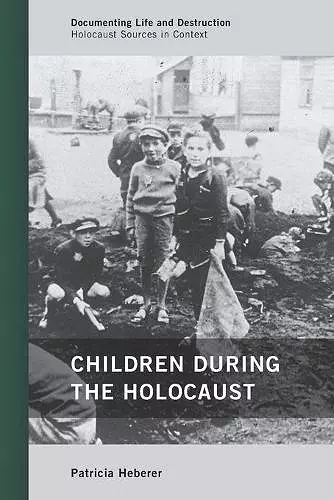Children during the Holocaust
Format:Paperback
Publisher:AltaMira Press
Published:24th Sep '15
Currently unavailable, and unfortunately no date known when it will be back

Children during the Holocaust, from the United States Holocaust Memorial Museum's Center for Advanced Holocaust Studies, tells the story of the Holocaust through the eyes, and fates, of its youngest victims.
The ten chapters follow the arc of the persecutory policies of the Nazis and their sympathizers and the impact these measures had on Jewish children and adolescents—from the years leading to the war, to the roundups, deportations, and emigrations, to hidden life and death in the ghettos and concentration camps, and to liberation and coping in the wake of war. This volume examines the reactions of children to discrimination, the loss of livelihood in Jewish homes, and the public humiliation at the hands of fellow citizens and explores the ways in which children's experiences paralleled and diverged from their adult counterparts. Additional chapters reflect upon the role of non-Jewish children as victims, perpetrators, and bystanders during World War II.
Offering a collection of personal letters, diaries, court testimonies, government documents, military reports, speeches, newspapers, photographs, and artwork, Children during the Holocaust highlights the diversity of children's experiences during the nightmare years of the Holocaust.
This substantial volume narrates and contextualizes the complex experiences of the youngest victims of the Holocaust. Of the six million murdered Jews of Europe, 1.1 million were children. The book not only honors their memory, but also gives a voice to the children who were killed and to those who survived the ordeal in hiding, in ghettos, or in concentration camps. * Holocaust and Genocide Studies *
Over one million Jewish children under age 14 were murdered during the Holocaust. Heberer (specialist, United States Holocaust Memorial Museum) has compiled and contextualized an impressive array of documentary evidence on the experiences and responses of children during the years before, during, and just after the war, focusing on Jews but with an additional focus on non-Jewish children who were not persecuted. As in the previous series titles (sponsored by the museum), the documents here are interspersed with both historical context about the sources and biographical data about their authors. The brevity of some documents magnifies their power. For example, the diary of Tanya Savicheya of Leningrad contains only nine lines, each chronicling the death of a family member, until she alone remains. In discussing her sources, Heberer reveals some interesting challenges in reconstructing children’s experiences. Young children rarely write reflective documents, and older children’s diaries largely reveal the experiences of teenagers, so an unavoidable bias toward the teen experience results. VERDICT While the collection focuses on Jewish children, it balances nicely with the wider experience of youngsters during World War II across the ethnic divides, making the book a valuable source for teaching the war years. * Library Journal *
As many as one-and-a-half-million children died as a direct result of Nazi racial policies, including more than one-million Jewish children. There are, of course, numerous accounts by survivors who endured the Holocaust as children, and Anne Frank’s diary is a wonderful example of one adolescent’s unique experience. Historian Heberer, a specialist at the U.S. Holocaust Memorial Museum, provides a wider ranging, comprehensive survey of the experiences of children who endured the Holocaust as well as the years and events that immediately preceded it. Relying primarily on first-person accounts and other primary sources, Heberer examines how children and adolescents reacted to the first stages of anti-Jewish activities, the onset of war, mass deportations, and life in the ghettos and then the camps. There are no punches pulled here, and much of this is tough, even disgusting material, especially as seen through the eyes of confused and often helpless victims. Nevertheless, this is an important contribution to Holocaust studies. * Booklist *
Children during the Holocaust is a most impressive volume. The archival sources incorporate a good range of genres including diaries, memoirs, eyewitness reports, and oral testimonies along with poetry, drawings, photographs, and other material. These source documents are each contextualized. As much of what is included is emotionally moving and sometimes even disturbing, the author’s narrative is well positioned, allowing the reader to come to terms with the implications of the documents and the reader’s own response to them without feeling overwhelmed. I could see the volume being useful both at the graduate and undergraduate level, and even as a resource for high school students. -- Sara Horowitz, The Centre for Jewish Studies, York University
The text of this book fully, deeply, and thoroughly addresses the major issues concerning children during the Holocaust. The author’s narrative is clear, concise, and consistently helpful. Taken as a whole, the illustrative documents reflect a wide-ranging yet meaningful knowledge of children’s lives. All too often our awareness of children during the Holocaust rests upon a few iconic figures, but in this book we see a much more nuanced and appropriately complex understanding of children. Through this sophisticated analysis, we come to understand how important age is to children’s fates and their experiences. -- Judith Gerson, Rutgers University
This excellent volume brings together a wealth of original documentation regarding one of the most important but least understood categories of people who experienced the Holocaust: children. Drawn from numerous countries and multiple languages, most of these documents have either never been published before or appear here in English for the first time. The emphasis on documentation produced during the Holocaust itself helps shed light on the experiences of children who did not survive to write memoirs or to record testimony. The author has masterfully integrated the documents into an incisive and highly readable analytical narrative. The book will be a valuable resource for scholars of the Holocaust, for teachers and students in high schools, and for anyone with a serious interest in the Holocaust. -- Alan E. Steinweis, University of Vermont
ISBN: 9780759119857
Dimensions: 229mm x 154mm x 34mm
Weight: 885g
556 pages